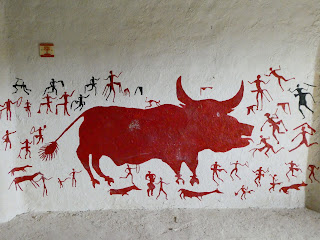After
spending a few days in the Cappadocia area where we went through 2 underground
cities and experienced the very interesting homes and sanctuaries carved out of
volcanic tuff, it was time to leave that area and travel through the
countryside to our next destination, Çatalhöyük. This area of Anatolia had been very wet and
swampy after the melting at the end of the last ice age. This was the time of the hunter gatherers, as
food and game was plentiful.
Small settlements sprung up on the slightly higher areas. As time went on, the land continued to dry
up, and layer upon layer of habitation built up in the same places so that
hills were created. These were called
höyüks, which means occupational mound, tumulus, or burial mound. We actually did visit what is purported to be
the tumulus, or burial mound of King Midas a few days previously.
The
höyüks were scattered about the countryside, and the vast majority of them have
never been excavated. Their newest
layers were at the top of the hill, and the archeologists had to dig down to
the bottom to get to the oldest and original layers. We were also transitioning out of the
volcanic geology and into the limestone geology. One site, Ashiklihöyük, was determined to be
10,000 years old, and obsidian shards from the production of arrow and spear
points littered the ground. Obsidian is
the product of volcanic eruptions. From
this point on, most of the shards would be flint.
So
that takes our journey to Çatalhöyük, purported to be the oldest city in the
world. It was built around 2 hills of
the Anatolian Plateau, and was occupied from 7500 BC to 5700 BC. The dwellings were cube shaped affairs, one
next to the other, with access only through the roofs. The site consisted of a small museum, several
reconstructed dwellings
with fine quality recreations of the original artwork inside on
the walls,
and 2 additional buildings that covered the excavation sites for
their protection.
The first drawing depicts a hunting scene with a deer, and the second is a scene with an aurochs, which is a primitive precursor to today's cattle. If you notice in the third scene, all of the men are wearing leopard skins. In this particular culture, the leopard was the sacred animal, the psycho-pomp, that escorted the deceased to the world beyond.
One excavation here is of
the older mound, and is very deep. When
that village was abandoned, the second one was built nearby, and the ruins are much
shallower because it was not occupied as long. The practice was to collapse
and compact the upper half of a room of the dwelling into the bottom half,
and rebuild on top of that. Thus, the
occupational mound got taller over time. Here are some photos looking down into the older and deeper ruin.
As you will see when we get to Gobekli Tepe, it is the same situation, where were were looking down into the ruins.









No comments:
Post a Comment